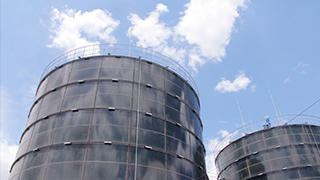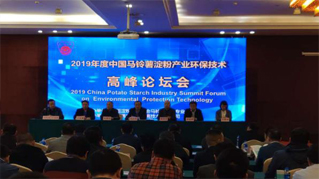The term “straw” refers to the residues of crops discarded after harvesting the seeds, like stems, leaves, stalks, shells, alfalfa and ear. Rich in nitrogen, phosphorus, potassium, calcium, magnesium and organic matters, straw is a kind of multi-purpose renewable biological resource and a kind of new energy with the highest potential of development and utilization and has good economic, ecological and social benefits.
Current Status of Straw Waste Utilization
High Theoretical Resources and Low Utilization Rate of Energy in Power Generation
In recent years, with the increase of China's support for modern agriculture, the crop planting area has been increasing, and the number of straw has also been rising sharply. According to relevant survey data, the theoretical resource of straw in 2018 was expected to reach 886 million tons. Insufficient comprehensive utilization of such huge straw resource wastes will not only cause a series of environmental problems but also waste valuable biological resources.
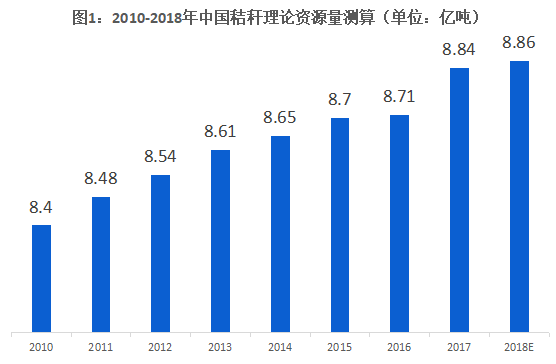
|
图1:2010-2018年中国秸秆理论资源量测算(单位:亿吨) |
|
Figure 1: Estimation of Theoretical Quantity of Straws Resources in China 2010-2018 (unit: 100 million tons) |
To this end, in October 2018, the Ministry of Agriculture proposed at the Northeast Straw Treatment Action Field Exchange and Results Exhibition Meeting, “By 2020, the comprehensive utilization rate of straw in the country will reach more than 85%” and issued the Action Plan for Agricultural and Rural Pollution Control War jointly with the Ministry of Ecology and Environment. According to data, at present, the comprehensive utilization rate of crop straw in China is close to 82%, 47.2% for fertilizer utilization, 17.99% for feeds and only 17.99% for power generation. It can be seen that the comprehensive utilization rate of crop straw in China is close to the national planning target, but the utilization rate of power generation is relatively low.
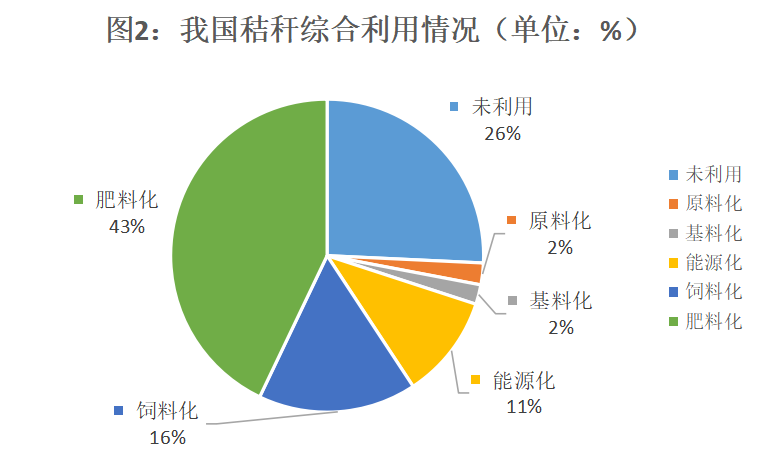
|
图2:我国秸秆综合利用情况(单位:%) |
Figure 2: Comprehensive Utilization of Straws in China (unit: %) |
|
未利用 |
Unutilized |
|
原料化 |
Used as raw material |
|
基料化 |
Used as base stock |
|
能源化 |
Used as energy |
|
饲料化 |
Used as feeds |
|
肥料化 |
Used as fertilizer |
Straw waste treatment market
Rapid Increase in Scale and Revenue Scale
Straw is an ideal green renewable resource. It was only used as a kind of rural living energy and livestock feed in the past. Now, it has entered into the modern industry and the energy field to rapidly improve comprehensive benefits. In 2017, the market size of China's straw waste treatment industry has reached RMB 331.7 billion, an increase of 3.5% compared with RMB 320.5 billion in 2011; The industry income reached RMB 188.40 billion, an increase of 0.8% year-on-year, and the industry's rate of return reached 56.8%; It is expected that the market size of straw waste treatment industry is to reach RMB 332.9 billion in 2018, and the scale of industry income is expected to continue to grow to RMB 189.09 billion.
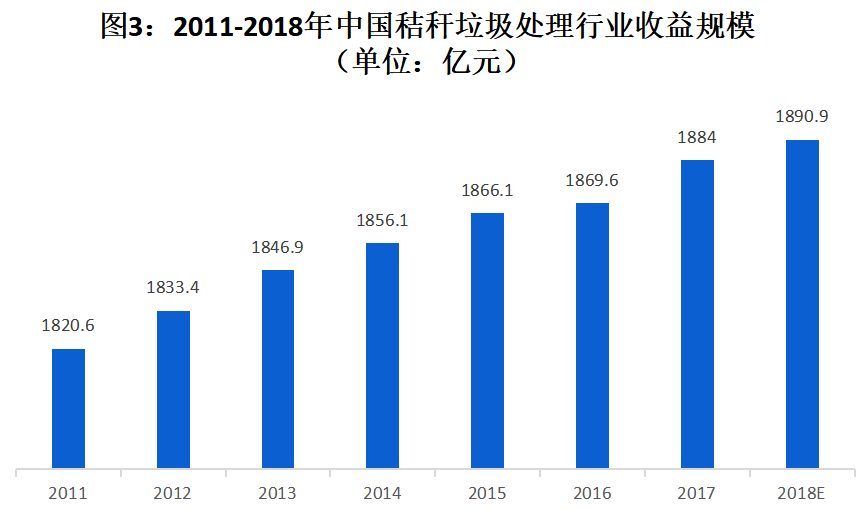
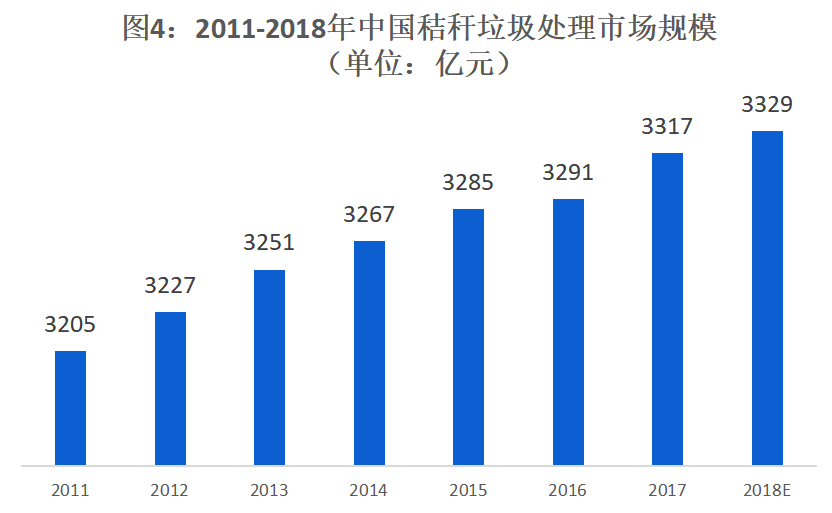
|
图3:2011-2018年中国秸秆垃圾处理行业受益规模(单位:亿元) |
Figure 3: Profits of China's Straw Waste Treatment Industry 2011-2018 (Unit: RMB 100 million) |
|
图4:2011-2018年中国秸秆垃圾处理市场规模(单位:亿元) |
Figure 4: Market Sizes of China's Straw Waste Treatment 2011-2018 (Unit: RMB 100 million) |
The utilization rate of straw waste treatment in China has been continuously improved, and the relevant technical level has been continuously improved. In the future, the market scale and the industry income scale of the straw waste treatment industry are expected to achieve sustained growth in the scale of the industry market under the huge straw output.
Straw Comprehensive Utilization Experiences Tortuous Development Yingherui SAHP Technology Boosts Industrialization Process
Among various utilization methods of straw, straw feed has the highest income with net benefit reaches RMB 717 / ton; followed by straw power generation with net benefit of RMB 173 / ton; The net benefit of the straw biogas also exceeds RMB 100 / ton, RMB 125 / ton.
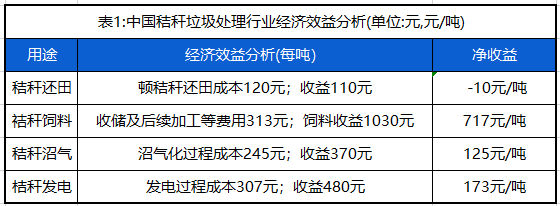
|
表1:中国秸秆垃圾处理行业经济效益分析(单位:元,元/吨) |
Table 1: Analysis of Economic Benefits of China's Straw Waste Treatment Industry (unit: RMB, RMB / ton) |
|
用途 |
Purpose |
|
秸秆还田 |
Straw turnover |
|
秸秆饲料 |
Straw feed |
|
秸秆沼气 |
Straw biogas |
|
秸秆发电 |
Straw power generation |
|
经济效益分析(每吨) |
Economic Benefit Analysis (Ton) |
|
顿秸秆还田成本120元;收益110元 |
Cost of per ton of straw turnover: RMB 120; income: RMB 110 |
|
收储及后续加工等费用313元;饲料收益1030元 |
The cost of storage and subsequent processing: RMB 313; feed income: RMB 1,030. |
|
沼气化过程成本245元;收益370元 |
Cost of biogasification process: RMB 245; income: RMB 370. |
|
发电过程成本307元;收益480元 |
Cost of the power generation process: RMB 307; income: RMB 480. |
|
-10元/吨 |
RMB -10 / ton |
|
717元/吨 |
RMB 717 / ton |
|
125元/吨 |
RMB 125 / ton |
|
173元/吨 |
RMB 173 / ton |
However, as an important means of clean utilization of straw and an important part of biomass power generation, the development of straw power generation industry in China is tortuous. From the perspective of variety distribution, China's straw varieties mainly include rice, wheat and corn. Among them, the proportion of corn stalks is the highest, reaching 32.5%, followed by straw and wheat straw.
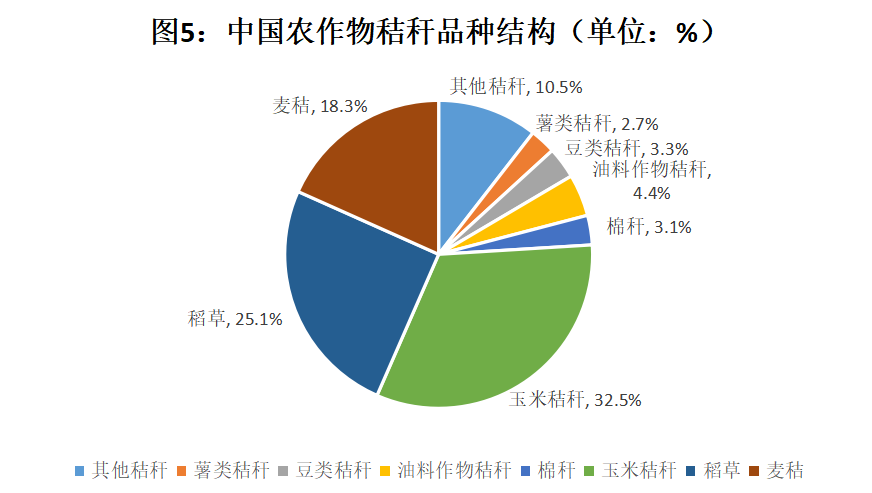
|
图5:中国农作物秸秆品种结构(单位:%) |
Figure 5: Chinese Crop Straw Variety Structure (unit: %) |
|
其他秸秆 |
Other straw |
|
薯类秸秆 |
Potato straw |
|
豆类秸秆 |
Bean straw |
|
油料作物秸秆 |
Oil crop straw |
|
棉杆 |
Cotton rod |
|
玉米秸秆 |
Corn straw |
|
稻草 |
Rice straw |
|
麦秸 |
Wheat straw |
These raw materials all have problems of high dry matter content and low moisture content, resulting in fiber shrinkage and outstanding hydrophobicity of the crystal structure. This makes the technical difficulty of anaerobic degradation increase, thus the whole industry is limited by the high cost and slow progress.
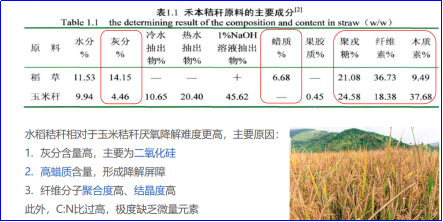
|
原料 |
Raw material |
|
稻草 |
Rice straw |
|
玉米杆 |
Corn rod |
|
水分 |
Moisture |
|
灰分 |
Ash |
|
冷水抽出物 |
Cold water extract |
|
热水抽出物 |
Hot water extract |
|
1%NaOH溶液抽出物 |
1% NaOH solution extract |
|
蜡质 |
Waxiness |
|
果胶质 |
Pectin |
|
聚戎糖 |
Polysaccharide |
|
纤维素 |
Cellulose |
|
木质素 |
Lignin |
|
水稻秸秆相对于玉米秸秆厌氧降解难度更高,主要原因: |
It is more difficult for rice straw to have anaerobic degradation relative to corn straw. The main reasons are: |
|
1. 灰分含量高,主要为二氧化硅 |
1. High ash content, mainly silica; |
|
2. 高蜡质含量,形成降解屏障 |
2. High wax content, forming a degradation barrier; |
|
3. 纤维分子聚合度高、结晶度高 |
3. High degree of fiber molecules polymerization and high degree of crystallinity; |
|
此外,C:N比过高,极度缺乏微量元素 |
In addition, the C:N ratio is too high and trace elements are extremely deficient. |
Under the impetus of national policies, specific to the characteristics of Chinese raw materials, Yingherui has cooperated with German advanced laboratories to complete a lot of experiments and researches and made constant improvements and perfection. It has developed the SAHP technology suitable for Chinese raw materials. The technology can obviously improve the hydrolytic acidification rate of raw materials to rapid the degradation rate of raw materials and boost the further improvement of the comprehensive utilization rate of the straw.




